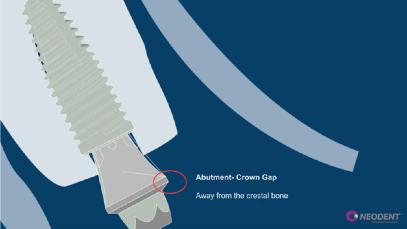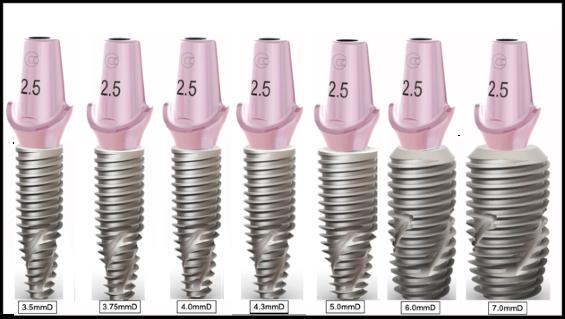Page 1: Response to video of doctors parroting Neodent’s talking points with salesperson Pages 2-13: An Analysis of the Shortcomings of the Neodent GM implant
1. “The single platform for all different sizes”
A single platform assure a poor emergence profile with the wider implants. That is why Straumann had to add a wide abutment that sets on the shoulder rather than the conical connection for its single platform BLX implants
2. “Predictability with Neodent”
You may get predictable Osseointegration with Neodent but you will also get predictable bone loss if you place the implant sub-crestal and predictable soft-tissue complications if its blasted, threaded collar becomes exposed.
3. “Uncomplicated”
of 1 11

An implant with a single internal connection diameter across 6 implant diameters may be “uncomplicated” from the standpoint of abutment selection, it does complicate creating an esthetic and hygienic emergence profile. The implant requires sub-crestal placement to allow a running room for the abutment to flair to a restorable diameter.
4. “Always get primary stability”
Research studies show that placing the implant sub-crestal reduces initial stability: https://www.niznick.com/pdf/Influence-of-Implant-Placement-Depth-on-Crestal-Bone-Stability.pdf
Dr. Dunlop has posted cases where he or his associate placed 16mm long implants in the anterior maxilla and had to immediately remove them and replace them with 18mm long implants to engage the cortical bone in the floor of the nose for stability. The reason Neodent is a less than desirable shape for consistently achieving initial stability regardless of the length of the implant, is because it is a relatively straight implant with a tapered apex.
5. “I get bone growth over the implant”
First of all, you may get bone growth over the implant but that is because the implant, with its blasted surface to the top and its single platform design, dictates that the implant should be placed sub-crestal. That leads to a variety of potential problems such has (1) having to contour the bone above the top of the implant to allow seating of flared healing collars and abutments and (2) bone will recede to below the implant-abutment junction.
6. “The platform switch”
Platform switching has been proven to be of not benefit in studies. It is just a product of using only one diameter connection over a range of implant diameters. https://issuu.com/dr.niznick/docs/02-28-2012_coir_article_refuting_pl?e=0
7. “Surgical performance of Neodent implant”
If by “surgical performance” you mean easy to insert, just remember that a fully tapered screw implant will achieve good initial stability without needing to drill a 16-18mm socket to receive a long implant. . You will also save surgical time if the implant is placed level with or slightly above the crest of the ridge as it will not require bone profiling to widen the top of the socket for seating of a flared healing collar or abutment.
8. “Long sizes and the sharp apex”
The longest implant in my new system will be 14mm…. No need for any longer to achieve good initial stability because the entire implant is tapered, not just the apex. A sharp apex can continue to cut its way into the bone rather than stop when a rounded apex hits the bottom of the osteotomy. Further more, a sharp apex can perforate the sinus membrane.
9. “Bone maintenance”
Crestal bone levels may be maintained once the bone recedes to the level of the implant-abutment junction which is usually placed sub-crestal. Implants with smooth necks, placed supra-crestal, have been shown in studies to have 1/3rd the incidence of peri-implantitis.
https://www.youtube.com/clip/UgkxFLqel8yA0VbEWv0VyR3r_urnDxh-5PUL
10. “Excellent reliable results…there is nothing like it.”
The Neodent is made from Grade 4 titanium that is 34% weaker than the titanium alloys most implants are made from. As for “excellent reliable results” it depends whether you are considering short-term vs long-term results and the occurrence of both mechanical and biological complications.
Click to view video
Neodent produced a graphic video entitled “Difference Between Crestal and Subcrestal Implant Position with Neodent Implants.” What it does is illustrate the fallacy of claims that subcrestal implant placement helps preserve crestal bone. The design of the Neodent System, with only 1 narrow (3 mm) connection for 7 implant diameters, dictates the need for subcrestal placement in order to create enough running room for the abutment to flare to a restorable diameter. Bone will resorb at or below the implant-abutment junction. This is an example
According to this illustration of an implant placed “Equicrestal” i.e. level with the crest of the ridge, bone loss of 0.5mm to 1.5mm could be expected. If this actually occurred, it could be due to many factors such as when the measurement was taken relative to the date of insertion, using too wide an implant for the ridge width or how the implant was allowed to heal, 2-stage, 1-stage or immediate load.
This illustration is of an implant placed 2mm subcrestal and it notes that “the expected bone loss is 0.03mm which is an amount that could not even be measured so it is pure speculation.
This illustration is of an implant placed 2 mm subcrestal with the abutment attached. It notes that the“Abutment-Crown Gap [is] away from the crestal bone.” This is accomplished by using a longer abutment. Where the Abutment Crown Gap is located is far less significant clinically, relative to bone loss, than where the implant-abutment Gap is located. As shown in this illustration, there is a space between the subcrestal portion of the abutment and the bone. This represents 2 mm of loss of bone support and creates an infra-bony defect around the implant so by placing the implant 2 mm subcrestal,



The Neodent GM has a 74 degree conical connection (not a 1.5 degree Morse Taper). This creates a long taper that thins the implant walls, already weakened by using Grade 4 rather than TiAlloy. The long taper precludes making 6mm short implants. The single narrow platform often needs to be placed subcrestal to create enough running room for the abutment to flare from the 3mm internal shaft diameter to an acceptable diameter to construct and esthetic restoration. Hygiene is compromised by the poor emergence profile. Placing an implant subcrestal often required countersinking of the crest of the ridge in order to seat a flared abutment.


Straumann recently acquired GalvoSurge Dental Implant Cleaning System used to treat peri-implantitis caused by bone loss resulting in exposed rough implant surfaces. It is recommended to first smooth the surface and remove any exposed threads before decontamination with GalvoSurge.
GEN5 Implants are designed with a 2.5mm machined, anodized neck with a blasted surface below, similar to Straumann’s TL implants which have been proven to experience about 1/3 the peri-implantitis of implants blasted to the top. This is in contrast to Neodent which has threads and its blasted to the top of the implant.

Paragon’s GEN5 implant (Pat.Pend) represents a paradigm shift in design and surgical protocol. It is designed to position the platform 1 mm above the crest by adding 1mm to the length of each implant. If you prepare for a 13mm implant, which is actually 14mm, 1 mm will be Supracrestal. You can still suture over it if you want a 2-stage surgery or you can prepare the cite for a 11.5 implant, screw in the 13mm implant stopping with the blasted surface level with the crest, and have 2.5mm of smooth neck for 1-stage surgery.




Neodent’s GM Implant is straight with a Tapered Apical Region.
The Tapered Screw-Vent (Niznick TSV- 1999) introduced a soft-bone surgical protocol, a process documented in a 2000 article by G. Niznick. A tapered implant inserted into an undersized socket will compress soft bone and increase initial stability. CoreVent, along with its TSV implant system was sold to ZimVie’s predecessor in 2001, its flagship product. The TSV generated 29% higher torque than NobelActive and 100% greater torque than Straumann’s straight bone level implant. The exact same tapered concept and surgical protocol with step drills was adopted by Implant Direct for its Legacy implants and by Paragon for its GEN5, GEN5+ and NizPlant implants.


GEN5 Surgical Tray provides Soft-Bone & Hard-Bone Guide. This surgical protocol is only effective with fully tapered implants. That excludes BLX and Neodent implants.

Neodent describes the coronal threads on its implants as beng trapezoidal and V-Shaped in the Apical region. These shapes are ideal for resisting pull-out from bone of an orthopedic screw BUT a reverse-buttress (flat based) thread is more effective ad distributing vertical forces of occlusion.
Straumann’s and Paragon’s implants utilize flat based threads for better load distribution





Fig. 1a shows distal Neodent 18mm long implants placed at about 45 deg. The dentist said that 16mm long implants were not stable so he went back with longer implants to engage the cortical bone under the nose. Note that the majority of the length of the Neodent implants is straight with just the apical portion tapered. A tapered implant will achieves good initial stability in soft bone.
Fig. 1b Based on this panoramic x-ray, 6 GEN5+ implants of varying lengths could be placed - Note the improved emergence profile

Fig. 2a shows 6 Neodent implants all placed below the yellow line which represents the 2D image of the highest level of the ridge, probably on the lingual. Three of the implants have angled abutments.
Fig. 2b 6 GEN5+ implants placed over the Neodent implant images with the implantabutment junction level with the bone image. If the ridge slopes down to the labial, GEN5’s 2.5mm smooth surface assures that its blasted surface will not be exposed to the soft tissue. Paragon’s ASC copings will correct the angle.




Price does not determine quality, but a very low price is only possible if the cost of manufacturing is also minimized. Neodent’s Braziian shopping cart showed these prices for its GM Drive and Helix implants with two different surface treatments. At the October 10, 2022, exchange rate of 5.19 Brazilian Reals to $1 US, the cost in Brazil for a Neodent implant with just the blasted surface is $23 ($229 in the US) and $30 for the “Acqua” surface ($269 in US)

Neodent’s long conical connection and single platform results in a poor emergence profile. The Neodent implant usually requires sub-crestal placement of the implant-abutment junction in order to provide enough “running room” to flare from the top of the implant to the restoration. Studies have shown that subcrestal placement of the implant-abutment junction compared to supra-crestal placement, contributes to bone loss and subsequent peri-implantitis.


Neodent has a conical implant/abutment connection NOT a Morse Taper. A Morse Taper is an engineering term describing mating surfaces each with about 1.5 degree taper, creating a friction fit. The lead-in bevel on the Neodent “Grand Morse” implant is 16 degrees off the vertical center line (74 degrees off the horizontal) so it is not a Morse Taper. For a conical connection to be effective at sealing the internal shaft against the ingress of bacterial, the bevel of the abutment needs to be 0.5 degree flatter than the bevel of the implant. As shown in this cross section of a Neodent implant and abutment from Neodent’s own marketing material, it is evident that the first contact between the taper on the abutment and the taper on the implant is occurring below the top, indicating either poor design or poor precision.
Increasing the angle of the bevel increases its length, thinning the walls of the implant. Furthermore, it increases the depth of the internal hex used for ratcheting the implant to place, thereby precluding Neodent system from including a 6mm long implant.






